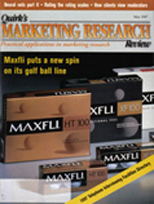Editor's note: Terra Friedrichs is founder of Product Management Associates, an Acton, Mass., research firm.
Asking the right questions in the right sequence is critical to successful telephone interviewing. Market research data gathered by telephone influences the spending of millions of dollars. Designing an effective questionnaire is essential to obtaining solid information on which to make investment decisions. It is essential that the person designing the questionnaire knows a client's goal for the project and can determine that the goals are realistic. The designer must also have some product knowledge and experience in what is being researched.
Obtaining accurate data depends on a combination of designing an effective questionnaire and the attributes of the interviewer. Topics to be covered in this article are: ordering the questions effectively, content of questions, asking both qualitative and quantitative questions, cultural issues, ensuring consistent answers, qualities of an ideal interviewer, appropriate length of questionnaire, use of prompts, and questionnaire flexibility.
Leverage brain power
The ideal questionnaire will order the questions to leverage a person's brain power and get them in the right mode to obtain the most comprehensive answers. The survey designer must have basic knowledge about the product and industry to insure that questions are asked in the right sequence. I use a technique that I call "tagging" of key questions to allow interviewers flexibility within the interview. There may be two or three ways to conduct an interview without sacrificing consistency. An ideal questionnaire will be flexible enough to allow the interviewer to navigate through it by taking different trails. I use tags to make sure that most critical questions are asked, and to guarantee that the interviewer can use the questionnaire with the greatest ease.
Questions must be probing enough to get to the heart of the client's focus. General questions on market size are good, but it is essential to ask specific questions to find out more specialized information. The smaller the niche being researched, the more critical are the questions.
A good questionnaire has the right mix of qualitative and quantitative questions. Intersperse "yes or no" questions with open-ended questions. Keep multiple choice answers brief enough for the person being interviewed to remember the choices easily. Interviewers must use the open-ended questions and prompts consistently from interview to interview. Interviewers can easily influence the outcome of a survey by how they ask a question. Make sure that the prompts are open-ended and do not provide a lead to the answer that could skew the results.
Effective sequence
One of the most critical aspects of survey is to ask questions in an effective sequence. Depending on the person being interviewed and their culture, it may be appropriate to ask warm-up questions first, leading up to tough questions. This is especially true in the Asia-Pacific region and in Latin America. On the other extreme, an American might say to an interviewer, "I have three minutes. What do you need to know?" In this case, it is essential to get right to the heart of the interview. Experience with the client's product helps an interviewer find that place.
The interviewer must be familiar with cultural customs. It is important to know which phrases to use and which not to use in the questionnaire. In every country, interviewers must trust their intuition and have a sense of the person they are interviewing.
The best-designed survey can be sabotaged by an untrained interviewer. An ideal interviewer must be able to maximize the productivity of time spent during an interview, and also use the questionnaire to custom fit their interviewee. Ask the most important questions in three different ways to guarantee getting the same answer. The military calls this "triangulation." Strategists learn to set up an attack from three different angles to enhance consistency. Likewise, asking key questions from three different perspectives insures the answer is the same each time.
A typical consumer questionnaire should last between two and five minutes. The more specialized the niche, the longer the interview can be. Take the example of a study that interviewed network engineers who were planning to use ATM switches. The goal was to determine what features they wanted to have on ATM switches. Since the design will directly influence their work, the engineers would talk for up to 90 minutes. When research has a direct impact on a person's job and the design of future products, the interviewee will tolerate a 30-to 90-minute interview.
When seeking a telephone research provider, make sure the firm designing the questionnaire has an understanding of these issues and is able to design a consistent and provocative questionnaire. A properly designed questionnaire obtains valuable information. Following these simple guidelines can insure quality results.
